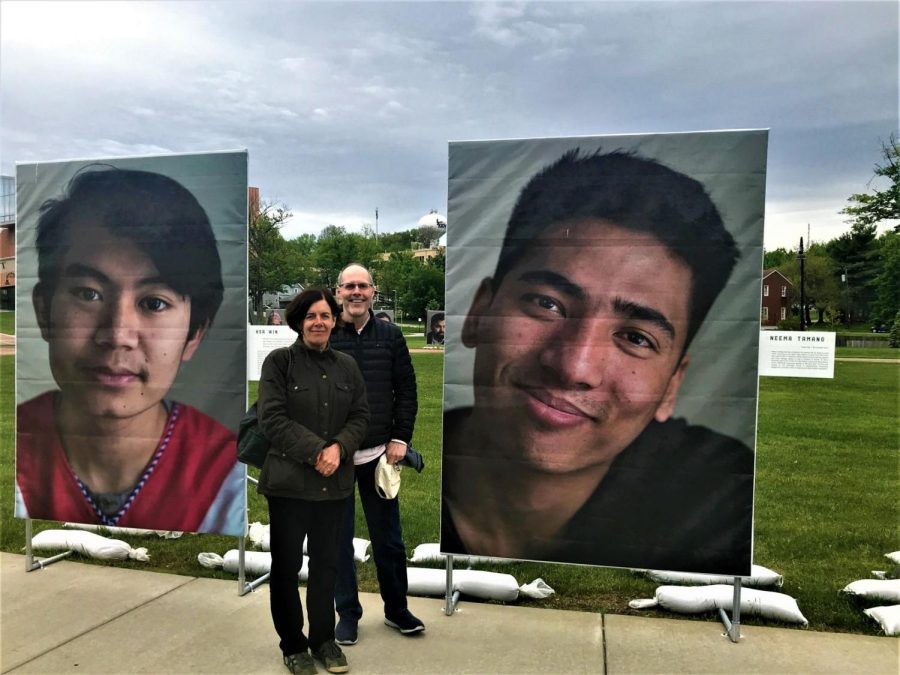New campus exhibit hopes to increase “global understanding”
May 26, 2019
Kent’s Global Understanding Research Initiative’s newest exhibit “We the People” gives refugees a platform to share their stories with the community.
The exhibit consists of portraits of 25 refugees living in or near Kent. They were made by photographer Erin LaBelle, a former Kent State photography professor. The photographs, each 7 feet by 5 feet, include a panel that describes the refugee’s personal history and journey.
“We the People” was organized by the Global Understanding Research Initiative, led by Francoise Massardier-Kenney and Paul Haridakis, and hopes to “emphasize our common humanity,” according to the website.
The Initiative’s project can be found near the Kent State University Arch at the corner of Willow St. and the Esplanade, where it draws the attention of drivers, cyclists and pedestrians.
According to Massardier-Kenney, the idea for the new exhibit is based on work by German artist Luigi Toscano, who created a Holocaust survivors exhibit at the National Holocaust Memorial Museum.
“I wanted to do something with photos because, especially in France, they do outdoor exhibits on all kinds of topics,” Massardier-Kenney said. “When I saw the Toscano exhibit, I figured out how we could do [this project].”
Several of the subjects of the exhibit are currently living in the Akron area, specifically North Hill, which is a widely diversified region, according to Haridakis. Haridakis said diversity has made the country what it is today.
“Northeast Ohio has always been a magnet for immigration,” Haridakis said. “What has been interesting to see is how the immigrants have revitalized North Hill and Akron with new businesses.”
“It just demonstrates how much immigrants have done for this country,” Haridakis said. “It reminds me how much immigrants have built Cleveland, built Akron and built the industries in this area all along.”
Massardier-Kenney said with the “unprecedented numbers” of refugees moving to other countries, it is important to remember that the United States is a country built on immigrants.
“A lot of people won’t be able to stay where they were born, because of climate change, wars,” Massardier-Kenney said. “That’s the new reality. At the same time, we are forgetting how [this country] came to be. Everybody, except Native Americans, comes from immigrants.”
In regard to the current political climate, Haridakis said it is important to understand refugees are still people, and they came here for the same reasons that many peoples’ ancestors did generations ago.
“A lot of the people are coming here because of violence and other conditions that make them leave,” Haridakis said. “They’re not criminals, they’re not coming here to wreak havoc; in fact, in many cases they’d rather be at home. If they had the opportunity, they would still be at home.”
For both directors of the Global Understanding Research Initiative, the refugees whose stories are being told through the exhibit are a source of inspiration and awe. Many of the immigrants spoke of being stuck without citizenship from any country, not even the country they were born. Others discussed going from living on the street to having to work their way through college.
“One of the participants found himself in a different country at 12 years old,” Massadier-Kenney said. “He has no family, lives on the street, doesn’t know the language. Then, 10 years later he’s a university student in a different country. It’s stunning! I don’t think I could do it, I really don’t.”
Haridakis said he wants people to understand that immigrants are essential to the livelihood of America and the Northeast Ohio region.
“To me, the message is how hard they’re working, how much they’re contributing and how much they’re assimilating,” Haridakis said. “People of the United States aren’t flocking to come to Northeast Ohio. If the area is going to grow and become more vibrant in the future, it will be because of immigrants. People aren’t breaking down the doors to come here from California.”
According to an article posted by the American Immigration Council, one in seven U.S. citizens are foreign-born, and that statistic is slowly rising. Given the flow of refugees into the country, Massardier-Kenney said the overall message of the exhibit should be one of acceptance and awareness of how the United States became the nation it is today.
“We became a thriving culture because of the influence of people from different cultures, bringing different ideas,” Massardier-Kenney said. “We are all, in one way or another, refugees or descendants of refugees. We are all human. Let’s treat newcomers as we wish others would treat us if or when we have to leave our country. And let’s listen to our neighbors’ stories.”
Brandon Justice is a correspondent. Contact him at [email protected].
Corrections were made to this story to reflect the correct capitalization of the name LaBelle and the phrasing involving the photographer making the portraits.

























